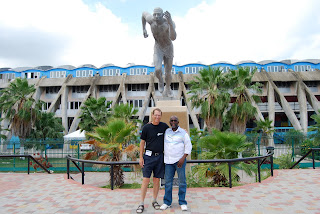
In the summer of 2007, I went to Kingston, Jamaica for a meeting of the Association for Cultural Studies at the University of the West Indies, Mona Campus just outside of Kingston. I was inspired to do this by a proposed panel on international hip hop involving Tony Mitchel (Global Noise), Bronwen Low from McGill and several others I had met in Mexico city the previous year at another conference. Another big factor was the personal encouragement I got from Kingston resident and popular music scholar Dennis Howard, whom I’d met and bonded with in Mexico City as well. As a longtime reggae fan, I felt like the notion of a personal visit to Trenchtown had some existential validity. Here’s Dennis and I in front of the national stadium and statue of Jamaican track legend Don Quarrie. Jamaica's national soccer team, whose team name is the Reggae Boyz, also plays here.
Island music has been intertwined with American and European popular music at least since the mambo craze of the 40s and 50s, but for boomers like me, it was Bob Marley and Chris Blackwell’s Island Records that brought it to the front of my consciousness in the late 60s with the reggae, rocksteady and ska styles. Blackwell was born a Londoner, but grew up in Jamaica and was able to parlay his familiarity with the local music scene into an enormously successful independent label which ended up back in London (where I spent a night in their studios in 1978 recording some demos).

Needless to say, Blackwell was long gone from Kingston in 2007 and the Trenchtown area didn’t have much going on in terms of music, and most of the commercial activity was informal. Dennis and Peter Tosh’s former manager Herbie Miller gave me a tour, which included meeting Dennis' father in his store, taking a few pictures in front of the Bob Marley statue, and cruising by the locations of famous studios and outdoor concert locations in the early reggae era. Herbie had perfectly plausible visions of turning the area into a tourist destination based on reggae stars and history. (See here for an update on that initiative.)
Live music in Kingston is pretty weak, right now, however, with the combination of sound systems and dancehall taking up most of that space. A sound system can get your attention: on weekends the parties in open spaces can be heard for blocks; when the legendary Stone Love system arrived in a dump truck and set up on campus, the massive subwoofers brought people out of buildings for a half-mile around, and made you question your bowel control.
Kingston itself has a reputation for violence, with more razor wire in evidence than is comfortable. My hotel told me to take a cab up to the Hilton for a drink; I looked out the door and it was 50 yards away. I walked. Most tourists to Jamaica end up on the north coast at Ocho Rios or Montego bay. Kingston draws more intrepid tourists but the city’s infrastructure isn’t strong, public transport inconsistent, and movement after dark needs to be cautious. Like many major cities, major capital has attempted to avoid inner-city constraints by building from scratch outside the center (think La Défense in Paris, Greenwich outside of London, Puebla in Mexico City), but New Kingston, as Dennis pointed out, was poorly planned, neglecting basic things like parking. The small maquiladora sector has now moved entirely to Asia and the economic base of the country was faltering even before the international crisis hit, with both sugar and tourism having problems.
This kind of an environment often puts the onus on the individual, and Dennis is no exception. As he completes his graduate work, he continues to run a production / event planning company with his partner, Jackie, which includes a gorgeous property up on Blue Mountain where a bunch of us were hosted for a meal at the conference end. In the meantime, he’s an accomplished scholar already, with his academic training buttressed by hands-on experience with many of the greats of Jamaican music. His blog is a must-stop for people interested in that history.
No comments:
Post a Comment